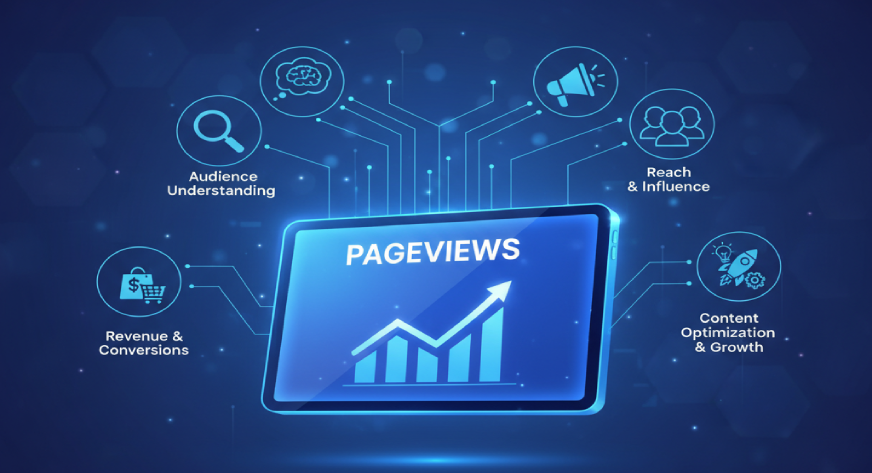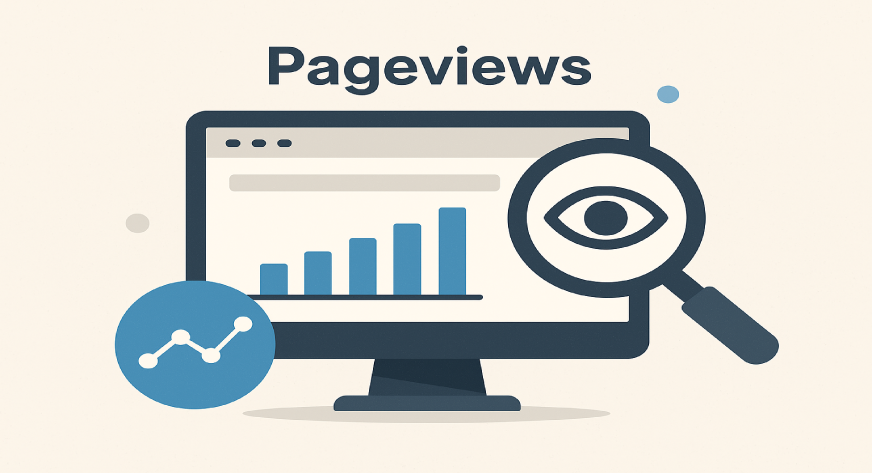
Pageviews refer to the total number of times a webpage is loaded or viewed by users. Each time a page is opened or refreshed, it counts as one pageview.
You can track pageviews using analytics tools like Google Analytics, Matomo, or Adobe Analytics. In Google Analytics, for example, you can view pageviews by going to Reports → Engagement → Pages and screens, where it shows how many times each page on your website has been viewed.
Understanding pageviews helps you see which pages your visitors enjoy the most, which pages may need improvement, and how often people return to your content. By tracking pageviews accurately, you can make smarter decisions about your website and content. In this guide, we’ll explain exactly what are the pageviews, how they work, and how to track them effectively.
What Pageviews Really Mean?
A pageview is counted every time a page is loaded in a browser. It doesn’t matter if it’s the same person visiting multiple times or different people visiting once, the page counts each load separately.
For example, if a person visits your homepage and then clicks through to three blog posts, that counts as four pageviews: one for the homepage and one for each blog post. If the same person refreshes a blog post, that refresh is counted as another pageview.
Why Are Pageviews Important?

Pageviews help you understand which pages attract the most attention. For example, if a blog post about healthy recipes gets 5,000 pageviews in a week, it shows that topic is popular with your audience.
Pageviews also give insights into user behavior. By comparing pageviews across different pages, you can see which topics keep visitors engaged and which pages might cause them to leave. This is especially useful for e-commerce sites, where high pageviews on product pages can indicate interest and help guide inventory decisions.
It’s important to remember that pageviews alone don’t measure engagement fully. A user could spend only a few seconds on a page but still count as a pageview. Combining pageviews with metrics like session duration or bounce rate gives a more complete picture of user activity.
Tools To Track Pageviews

Several tools can help you track pageviews accurately:
- Google Analytics (GA4) – This is the most widely used tool for tracking pageviews. GA4 provides reports showing how many pageviews each page receives, how users move through your website, and what devices or locations they use.
- Google Tag Manager – Useful for more complex tracking. You can set up pageview tracking for dynamic pages, single-page applications, or custom interactions.
- Other analytics tools – Tools like Matomo, Clicky, or Adobe Analytics also track pageviews, offering additional customization options.
- Server logs – For technical audiences, server log tracking records every page request. While not as user-friendly as GA4, it provides raw data for precise counting.
Accuracy depends on proper setup. If your tracking scripts are missing or incorrectly installed, your pageview numbers can be misleading.
How To Set Up Pageview Tracking?
Tracking pageviews correctly ensures you get reliable data. Here’s how to do it using Google Analytics 4 (GA4):
- Create a GA4 property – Sign in to Google Analytics and create a property for your website.
- Install tracking code – Copy the GA4 tracking code and place it in your website’s header. CMS platforms like WordPress or Shopify often offer plugins to make this easier.
- Verify tracking – Use GA4’s real-time reports to make sure pageviews are being counted correctly.
For dynamic pages or single-page applications, set up virtual pageviews. This ensures pageviews are counted even when the page doesn’t fully reload.
Filter out internal traffic, such as your own team members, to prevent skewed numbers. Regularly check your tracking setup to avoid double-counting or missing pages.
Common Mistakes To Avoid
Even though tracking pageviews seems simple, there are common mistakes:
- Counting bots or spam traffic – Some automated traffic can inflate pageview numbers. Use GA4’s bot filtering feature.
- Not tracking dynamic URLs – Pages that load content without a full page refresh may not count pageviews unless virtual pageviews are set up.
- Using outdated scripts – Old or incorrectly installed GA code can miss some pageviews.
- Misunderstanding unique vs total pageviews – Always check which metric you’re using when analyzing performance.
Regular audits of your analytics setup help keep data accurate and meaningful.
Also Read, 10 Stages of Web Development you Should Know!
Advanced Tips For Tracking Pageviews
For websites that need more than basic tracking:
- Use virtual pageviews for content that updates without a full reload. For example, a news website loading articles dynamically.
- Track custom events alongside pageviews, like video plays or PDF downloads, to see how users interact with content.
- Segment pageviews by device type, location, or traffic source to understand your audience better.
- For SEO, focus on high-traffic pages and improve internal linking to boost visibility.
- Set goals in GA4 to see how pageviews translate into actions, like newsletter sign-ups or purchases.
For those wondering, “what are pageviews in GA4” specifically: GA4 tracks every page load with a built-in page_view event, making it easier to monitor trends and user behavior without complex setup.
Key Takeaway
Pageviews are a simple but powerful metric to understand how people interact with your website. By knowing what are the pageviews, tracking them correctly, and interpreting the data carefully, you can make better decisions about content, website structure, and marketing efforts. Tools like GA4 make it easy to track pageviews accurately, while also offering insights into user behavior, device usage, and traffic sources. Regular monitoring ensures your data stays clean and useful, helping your website grow and serve your audience better.
Tracking pageviews isn’t just about numbers; it’s about understanding your visitors and improving their experience. By combining pageviews with other key metrics, you get a clear picture of what works and what can be improved on your website.
If you’re looking for expert help to track, analyze, and optimize your website traffic, Webworks Co. offers digital marketing services that include website analytics setup, reporting, and insights to help you make data-driven decisions.
Frequently Asked Questions
Q1. How are page views counted?
Page views are counted each time a webpage is loaded or refreshed by a user. If the same user reloads the page multiple times, each load counts as a separate page view.
Q2. What does page_view mean in Google Analytics?
In Google Analytics, a page_view event is triggered whenever a user loads or reloads a webpage with the tracking code. It helps measure how often each page on your website is viewed.
Q3. What is a good number of page views?
A “good” number of page views depends on your website type and goals. For small or niche websites, 1,000–5,000 views per month can be good, while larger or commercial websites may aim for 50,000+ page views per month. Quality engagement is more important than just high numbers.
